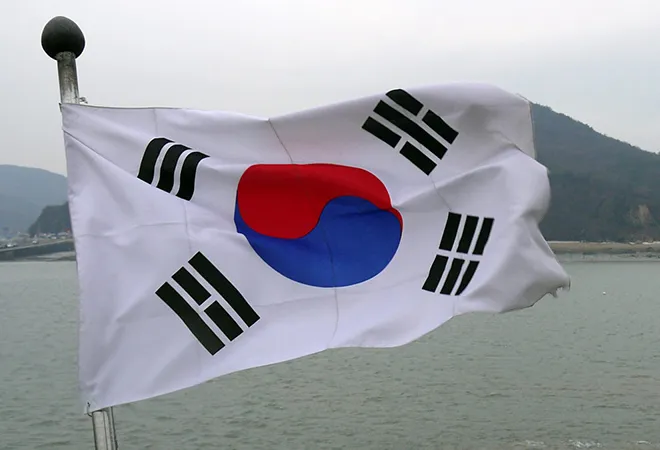-
CENTRES
Progammes & Centres
Location

On December 28, 2022, the Republic of Korea (ROK) unveiled its Indo-Pacific strategy. The ROK started working on this strategy right from the time of the coming of the Yoon Suk Yeol administration. The strategy states that the ROK aims to emerge as a ‘Global Pivotal State’, that is “it actively seeks out agenda for cooperation and shapes discussions in the region and the wider world”.
For the ROK, the Indo-Pacific besides being an economically vibrant region, is also the region which is home to partners of strategic industries such as semiconductors. Additionally, the region is also beset with challenges that threaten a peaceful, free and prosperous and a rules-based regional order. These challenges range from great power competition, deepening of arms race, lack of action to build transparency and trust in the military and security domains, North Korea’s build up of it nuclear and missile capabilities, disruption in supply chain networks.
The Indo-Pacific besides being an economically vibrant region, is also the region which is home to partners of strategic industries such as semiconductors.
The ROK aims to implement its Indo-Pacific strategy based on three principles of cooperation- ‘inclusiveness, trust and reciprocity’. To ensure inclusiveness, the ROK’s Indo-Pacific strategy implicitly states that, “our inclusive Indo-Pacific Strategy neither targets nor excludes any specific nation. We will work with every partner that is aligned with our vision and principles of cooperation. We will remain open to nations both in the Indo-Pacific region and beyond”. To achieve its aim of emerging as a ‘Global Pivotal State’, besides deepening bilateral engagements, the ROK aims to enhance cooperation by undertaking a ‘multi-layered and comprehensive approach’ and pursue partnerships with minilateral groupings, regional and global organisations. The scope of cooperation will extend beyond just Northeast Asia to key regions within the Indo-Pacific like Southeast Asia, South Asia, Oceania, and the African Coast of the Indian Ocean, Europe, Latin America and ‘develop a network of strategic partnerships tailored to each region’.
Given that ASEAN is a key partner and pivotal for the maintenance of peace and security in the Indo-Pacific, the ‘Korea-ASEAN Solidarity Initiative’ has been announced. The strategy also states that the ROK firmly supports the ASEAN Outlook on the Indo-Pacific. The main areas where cooperation will be strengthened are: digital, climate change and environment, and health. When it comes to security cooperation, focus will not be only on traditional security issues like the South China Sea, but also on economic, maritime security and other emerging security issues. In South Asia, stress has been given on further strengthening ‘the special strategic partnership with India’. The strategy outlines that, “India presents great potential for growth, having the world’s second largest population and cutting-edge IT and space technologies.” Furthermore, through high level exchanges, upgrading the ROK-India Comprehensive Economic Partnership Agreement (CEPA) the foundation of this bilateral relationship will be made stronger. In Oceania, with Australia, new areas of merger and collaboration have been identified like national defense, defense industry, security, critical minerals, climate change response, and supply chains. Climate change will be the focus area while working with the Pacific Island nations. Support for initiative like the 2050 Strategy for the Blue Pacific Continent, the Pacific Island Countries through the Partners in the Blue Pacific (PBP), will be extended as well. Maritime security cooperation will be the main area of cooperation with the countries of East Africa and the Indian Ocean littorals. Therefore, broadening the geographical ambit of cooperation to the entire Indo-Pacific region will be the primary agenda in implementing the Indo-Pacific strategy.
Climate change will be the focus area while working with the Pacific Island nations. Support for initiative like the 2050 Strategy for the Blue Pacific Continent, the Pacific Island Countries through the Partners in the Blue Pacific (PBP), will be extended as well.
During Moon Jae-in presidency, the ROK had initiated the New Southern Policy, which was aimed to expand the country’s area of focus and interest beyond just the Korean Peninsula and Northeast Asia. Southeast Asia and India formed the focal points of this policy. The current Indo-Pacific strategy is a step ahead from the previous New Southern Policy. It can be said that the New Southern Policy did provide the foundation for the evolution of the current government’s Indo-Pacific Strategy. This is a more comprehensive and an elaborate document as all the major regions within the Indo-Pacific geography finds a mention in this strategy and areas have been tailored out to cultivate a proper functional relationship with countries in Southeast Asia, South Asia, Oceania, and the African Coast of the Indian Ocean, Europe, Latin America. Diplomacy and engagement will not just happen bilaterally, but the desire to join minilateral platforms with which common interests and values are shared have also been laid out. Platforms like the Quadrilateral have been applauded and the keenness to join certain initiatives such as on infectious disease, climate change and critical and emerging technology under the Quad has also been expressed.
For the implementation of the Indo-Pacific strategy, nine core lines of effort have been drawn up. This section will highlight the significant lines of effort.
The crux of the ROK’s Indo-Pacific strategy is that “cooperation amongst countries in and outside the region is more keenly needed now than ever before”. The ROK as mentioned above aspires to be a ‘Global Pivotal State’ in the Indo-Pacific to play a bigger and more influential role in the region. It lives up to its statement of mapping out areas for cooperation tailored for each region. This document carefully identifies challenges unique to regions and geographies and provides a blueprint to deal with them in collaboration with other like-minded countries of the Indo-Pacific like the US, Australia, Japan among others. This document does not just put out some generalised areas of cooperation, but very clearly points out domains and challenges which pose real challenges to countries in the Indo-Pacific and therefore require the much needed attention.
The views expressed above belong to the author(s). ORF research and analyses now available on Telegram! Click here to access our curated content — blogs, longforms and interviews.

Premesha Saha is a Fellow with ORF’s Strategic Studies Programme. Her research focuses on Southeast Asia, East Asia, Oceania and the emerging dynamics of the ...
Read More +